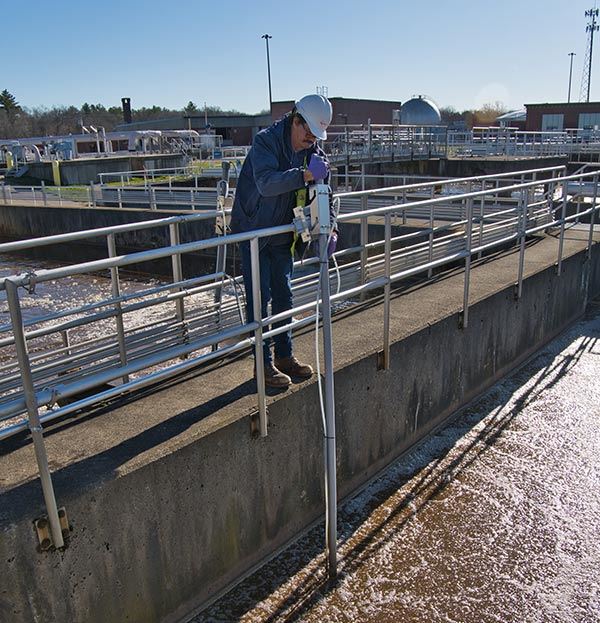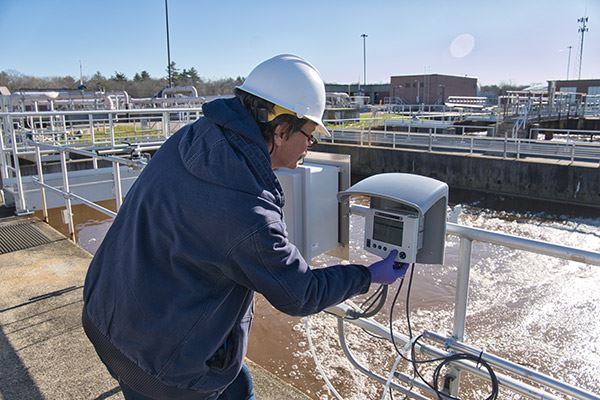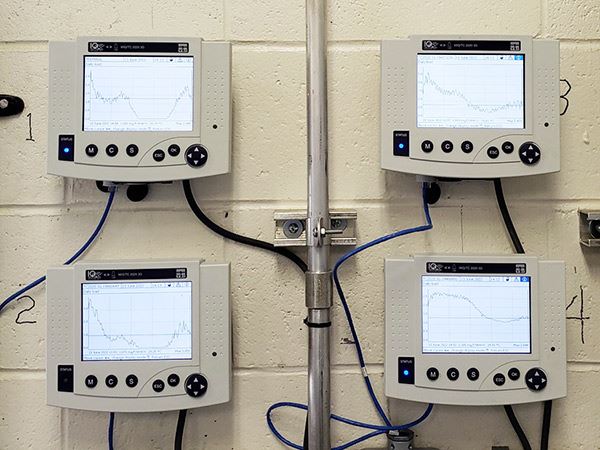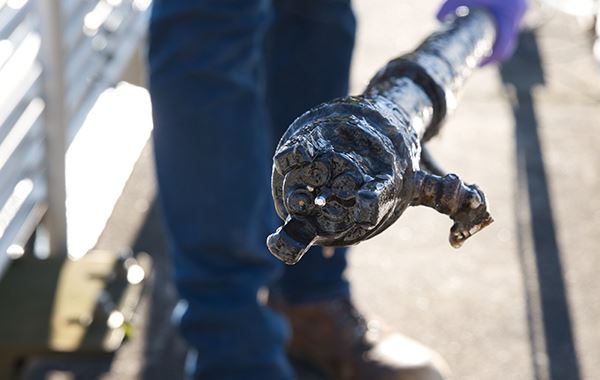Online Ammonium Sensor Placement for Improved Ammonia-Based Aeration Control
Wastewater facilities are continually looking for ways to optimize their process and save on operating expenditures. In recent years, ammonia-based aeration control (ABAC) has been sought-after as the next advancement in aeration control technology. With ABAC, facilities have seen drastic reductions in blower usage and energy savings of around 10-20% over dissolved oxygen control, including other benefits like reduced carbon dosing and alkalinity demand. The concept of ammonia-based aeration control is simple - utilize continuous ammonium (NH3/NH4+) measurements to control aeration in real-time to maintain an ammonium setpoint. The amount of air provided to the basins is just enough to meet their National Pollutant Discharge Elimination System (NPDES) permit limit while eliminating instances of over-aeration.
A crucial aspect of implementing an ammonia-based aeration control system is ammonium sensor placement. Should the control sensor be near the influent of the activated sludge basins, at the effluent of the activated sludge basins, or somewhere in between? That is the question the team at Brockton Advanced Water Reclamation Facility (AWRF) in Massachusetts set out to answer for their facility upgrade. Dave Norton (Plant Supervisor), CDM (engineering consultant), and John Downey (Instrumentation Manager) prepared to upgrade their aeration grid and implement ABAC in three phases.
First, the team wanted to determine which ISE sensors would work best for their application by conducting an 18-month trial with three manufacturers’ ion-selective electrode (ISE) ammonium sensors. Second, new aeration equipment and YSI sensors were installed over the next 12-month period. The final phase was to optimize ABAC by evaluating the performance of the ISE sensors at different stages of the activated sludge basins over seven months.

John Downey | Instrumentation Manager for Brockton Advanced Water Reclamation Facility.
Head-to-Head Trial
During the 18-month trial, Dave Norton assessed YSI’s ISE sensors against two other manufacturers and drew several conclusions. First, when applied correctly, the ISE sensor technology effectively controlled aeration in an ammonia based aeration control strategy. These sensors measure continuously and accurately when maintained well and in an environment with ammonium above 1.0 mg/L NH4-N. Second, ISE sensors have several advantages for ABAC compared to wet-chemistry analyzers. Compared to wet-chemistry analyzers, ISEs have a faster response time, are more affordable, and are easier to maintain in most applications. (Learn more, Tech Comparison ISE vs Analyzer for Ammonmium Monitoring). Finally, the team wanted all YSI sensors for their activated sludge process. The support and expertise provided by YSI, along with the performance of the sensors versus the competition, made YSI the clear choice.

Activated Sludge Basins | Each equipped with a YSI IQ SensorNet system and several sensors to monitor and control their activated sludge process.
Installation Period
Rehabilitation of the seven Brockton AWRF basins and installing the YSI IQ SensorNet systems occurred over 12 months. In addition to reducing excess aeration, the facility aimed to improve its total nitrogen (TN) removal with the upgrade. Therefore, pre-anoxic zones were implemented on all basins, including a second anoxic zone to denitrify further and remove TN. Each basin had its own YSI IQ SensorNet system, including three FDO dissolved oxygen sensors, one SensoLyt pH sensor, one AmmoLyt ammonium ISE sensor, and two UV NitraVis nitrate sensors. After all seven basins were brought online, the YSI sensors at each basin immediately showed their value. Even with flow spread evenly back to the basins, each had its unique environment with different volumes, velocities, and biology, causing differences in nitrification. To assess these variances and implement ammonia-based aeration control in each basin, John Downey was tasked with optimizing the process over the next seven months and experimenting with ammonium sensor location for the best aeration control.
Process Optimization Period
The 7-month process optimization period revealed many advantages and disadvantages for each ammonium measuring location in the activated sludge basins. The effluent of the activated sludge basins proved to be the least effective for several reasons. In theory, this location is attractive for sensor placement because operators know precisely how much ammonium is bleeding through to the clarifiers and feedback strategies are very common in control logic. (Learn more, Myths and Realities: Ammonium Based Aeration Control in Wastewater). Controlling with an ammonium measurement at this location would automatically adjust the blower output upstream of the sensor based on the sensor value. However, with this sensor placement, it is common to have readings near zero ammonium, which causes several issues. From a data perspective, a sensor always reading zero is not necessarily providing valuable data.
Although the operators can confirm that the effluent ammonium is near zero, they cannot determine how far upstream nitrification is complete, resulting in additional aeration and wasted energy (Figure 1). From a sensor perspective, the effluent measuring location was problematic as well. Ion-selective electrode sensors can be notorious for being difficult to maintain and may provide inaccurate data at concentrations below 0.5 mg/L NH4-N. Accuracy can be a limitation of ISE technology at low concentrations, and calibrating to near zero means the sensor may not react to ammonium when it is seldom exposed to higher concentrations. Also, interferences of similar ions, such as potassium (K+), have a more significant impact near zero ammonium. Choosing a location with measurable and fluctuating values typically provides better optimization and sensor performance for ammonia-based aeration control. (Learn more, Reliable Ammonium and Nitrate Measurements from Online ISE Sensors).

Figure 1 | Sensors placed near the effluent of aeration basins may cause several issues. This diagram demonstrates that the sensor will likely read near zero, but operators will not know where nitrification is complete.
The influent of the activated sludge basins demonstrated improvements over the effluent measuring location. This location provided much more valuable data to optimize aeration with the ability to monitor diurnal flows and ammonium loading coming into the basins. In addition, with the sensor consistently measuring at higher values, the sensor was more reliable, more accurate, and maximized the lifespan of the electrodes. However, John noted two potential difficulties at this location, the first when utilizing feedforward ABAC with a single sensor at the influent. Feedforward is a control strategy in which an upstream sensor automatically adjusts the downstream blower output. This sensor location is too far upstream to ensure that the effluent ammonium will meet its effluent permit. The finetuning of the controls would be difficult, and several factors within the basin could affect downstream nitrification, which the operators would not know about.
Second, John found that with the higher ammonium values at the influent, it was more difficult to calibrate the ISE sensor with a reference grab sample, as the ranges for available tests required dilutions to get values.
The most effective ISE sensor location for ABAC was the middle of the aeration basins, specifically where ammonium concentrations fluctuated daily between 1-5 mg/L NH4-N. ISE sensors perform remarkably at this location and provide data to best optimize aeration with a real-time ammonium measurement. During peak load times in the afternoon and evening, ammonium measurements would climb to 4-5 mg/L NH4-N, which at this point, the blowers were ramped up higher to provide more air to the aerobic zones. Then when loads dropped overnight, blower output was reduced to a minimum or shut off completely to denitrify more, resulting in better TN removal and energy savings (Figure 2).

Figure 2 | Ammonium sensors placed where nitrification is nearly complete (1-5 mg/L NH4-N) provide the best location for controlling aeration.
The Brockton AWRF team performed significant work to determine the correct location to place the sensor, using both grab samples and short trials to find the most effective location. John also discovered seasonal differences in where nitrification is complete. In the summer months, the sensor may need to be placed further upstream since nitrification occurs faster, but the sensor will be placed further downstream during colder months. However, the benefits of this sensor placement justify the work to find it. The diurnal loading trends from the ammonium ISE sensors provide valuable information on nitrification rates and optimal data to fine-tune aeration output. This location allows for a reasonable ammonium setpoint, which ensures that effluent ammonium is still below the permit limits and enough ammonium for the sensor to perform well (above 1 mg/L NH4-N).

Continuous Data | Daily trend of ammonium in each train provided by YSI AmmoLyt (NH4+) sensors. Each sensor shows an increase in ammonium during high loading in the day, followed by a decrease in ammonium overnight as shown on the panel of IQ SensorNet 2020 Controllers.
Conclusion
Brockton AWRF chose the YSI sensors over the competition for their performance, ease of use, and support level from YSI. During the optimization period, John Downey maintained the sensors with guidance from YSI experts to learn what was required to achieve reliable data with the ISE sensors. When asked about his impressions of the sensors, John said, “I believe the number. When the sensors are placed in a location that keeps them sensitized, they are very accurate!” John also enjoys the simplicity of maintaining the sensor.

Sensor Reliability | John Downey finds YSI sensors reliable, accurate, and easy to maintain. With over fifty YSI sensors to maintain, sensor reliability is most important to ensure Brockton AWRF meets its treatment goals.
Their ammonium ISE sensors have air-cleaning compressors to keep the electrodes clear from solids, but they still pull up the sensors every few months to clean the electrodes manually. John also performs a matrix adjustment (calibration via match to lab sample) every few months when the sensor drifts from a verification measurement, which is as easy as entering the lab number for the sensor measurement to match. Finally, replacing electrodes is quickly done by screwing the electrode into the sensor with the provided tool.
Perhaps the most significant determining factor for the Brockton AWRF team was the expertise and support provided by YSI during the trial. John and Dave were impressed with the knowledge and expertise shown by the team at YSI and Anthony Papile (NE3, New England Environmental Equipment). Anthony assisted in the commissioning of each basin and regularly followed up to ensure the system was performing well. In addition, any requests from the Brockton AWRF team were met with timely responses and thorough technical support. By choosing YSI, John and Dave knew they were in good hands.

